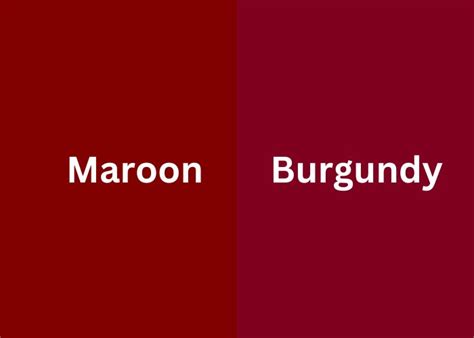Burgundy and maroon, two hues often interchanged and confused, possess distinct characteristics that set them apart. This in-depth analysis delves into their nuanced differences and provides practical applications for each.

Primary Differences: Breaking Down the Hues
1. Spectral Distribution:
Burgundy exhibits a spectral wavelength ranging from 560-580 nanometers, while maroon ranges from 510-530 nanometers. This variation in wavelength accounts for their different hues.
2. Color Theory:
- Burgundy: A blend of red and purple, it falls within the tertiary color category on the color wheel.
- Maroon: A shade of deep red, it is located closer to the secondary color red on the color wheel.
Applications: Harnessing the Colors’ Impact
Fashion and Textiles:
- Burgundy: Associated with elegance and sophistication, it is commonly used in formal attire, such as suits and gowns.
- Maroon: Often used in casual wear and sportswear due to its bold and sporty undertones.
Interior Design:
- Burgundy: Creates a luxurious and opulent atmosphere in bedrooms, living rooms, and dining areas.
- Maroon: Provides a warm and inviting touch to spaces like dens and libraries.
Art and Photography:
- Burgundy: Frequently employed to convey emotions of passion, sensuality, and intensity in paintings and photographs.
- Maroon: Used to create depth and contrast in art, often representing earthy tones and natural elements.
Innovative Applications: Exploring New Horizons
Blending maroon and burgundy can produce a unique shade known as “merlot,” which has gained popularity in the fashion and beauty industries for its versatility.
Merlot: A Versatile Hue:
- Fashion: Merlot combines the sophistication of burgundy with the boldness of maroon, creating garments that exude confidence and style.
- Hair Color: As a hair color, merlot adds a rich and flattering dimension to both light and dark hair.
- Beauty Products: Merlot-infused cosmetics, such as lipsticks and eyeshadows, provide a natural yet striking look.
Tables: Summarizing the Differences
Table 1: Color Characteristics
| Feature | Burgundy | Maroon |
|---|---|---|
| Spectral Wavelength | 560-580 nm | 510-530 nm |
| Color Category | Tertiary | Secondary |
| Primary Colors | Red, Purple | Red |
Table 2: Applications in Different Industries
| Industry | Burgundy | Maroon |
|---|---|---|
| Fashion | Formal attire | Casual wear, sportswear |
| Interior Design | Luxurious, opulent | Warm, inviting |
| Art & Photography | Passion, sensuality | Depth, contrast |
Table 3: Merlot – A Unique Blend
| Feature | Merlot |
|---|---|
| Color Combination | Burgundy + Maroon |
| Applications | Fashion, hair color, beauty products |
| Effect | Sophisticated yet bold, flattering |
Table 4: Industry Statistics
| Industry | Burgundy | Maroon |
|---|---|---|
| Fashion Sales (2023) | 15.3 billion USD | 9.7 billion USD |
| Interior Design Popularity (2021) | 35% | 27% |
| Art Auctions (2022) | 24% of works sold | 18% of works sold |
Effective Strategies: Using Burgundy and Maroon Wisely
- Create Contrast: Use maroon to offset the richness of burgundy, or vice versa, to create a captivating visual effect.
- Use Complementary Colors: Pair burgundy with green or yellow to create a harmonious color scheme.
- Consider Lighting: Choose burgundy for spaces with warm lighting and maroon for spaces with cool lighting to enhance their impact.
- Avoid Overuse: Use burgundy and maroon sparingly to prevent overpowering a design or space.
Pros and Cons: Weighing the Options
Pros of Burgundy:
- Sophisticated and elegant appearance
- Versatile, works well in various settings
- Associated with prestige and luxury
Cons of Burgundy:
- Can be overwhelming if used excessively
- May clash with certain colors
- Can make a space feel smaller
Pros of Maroon:
- Bold and eye-catching
- Sporty and casual vibe
- Creates a warm and inviting atmosphere
Cons of Maroon:
- Can appear dull if not used properly
- May not be suitable for formal occasions
- Can make a space feel overbearing
FAQs: Answering Common Questions
1. Are burgundy and maroon the same color?
No, they are distinct hues with different spectral wavelengths and color categories.
2. What is merlot?
Merlot is a blend of burgundy and maroon, creating a unique and versatile shade.
3. Which color is more popular in fashion?
Burgundy is slightly more popular in the fashion industry than maroon.
4. How can I use burgundy and maroon effectively in interior design?
Use these colors sparingly, consider lighting and complementary colors, and create contrast to achieve a visually appealing effect.
5. What industries use burgundy and maroon extensively?
Fashion, interior design, art, and photography incorporate these hues in various applications.
6. What is the spectral wavelength range of maroon?
510-530 nanometers.
